Operations & Project Management: Tesco Case Study & Recommendations
VerifiedAdded on 2023/06/10
|14
|3851
|203
Report
AI Summary
This report provides a detailed analysis of operations and project management within Tesco, a multinational retail supermarket. It explores the application of operations management principles, including the Six Sigma methodology, and examines relevant theories and concepts for continuous improvement. The report covers topics such as defining value, mapping the value stream, creating flow, establishing pull, and pursuing perfection through lean principles. It evaluates Tesco's continuous improvement plan, critiques its operations management principles, and offers recommendations for enhancing operational functions, such as customer focus and process management. Additionally, the report delves into the project life cycle, analyzing project methodologies, tools, and leadership within the context of a change program for a manufacturing organization, emphasizing the importance of employee well-being and strategic planning for organizational success. Desklib provides access to similar past papers and solved assignments for students.

Operations and
Project Management
Project Management
Paraphrase This Document
Need a fresh take? Get an instant paraphrase of this document with our AI Paraphraser
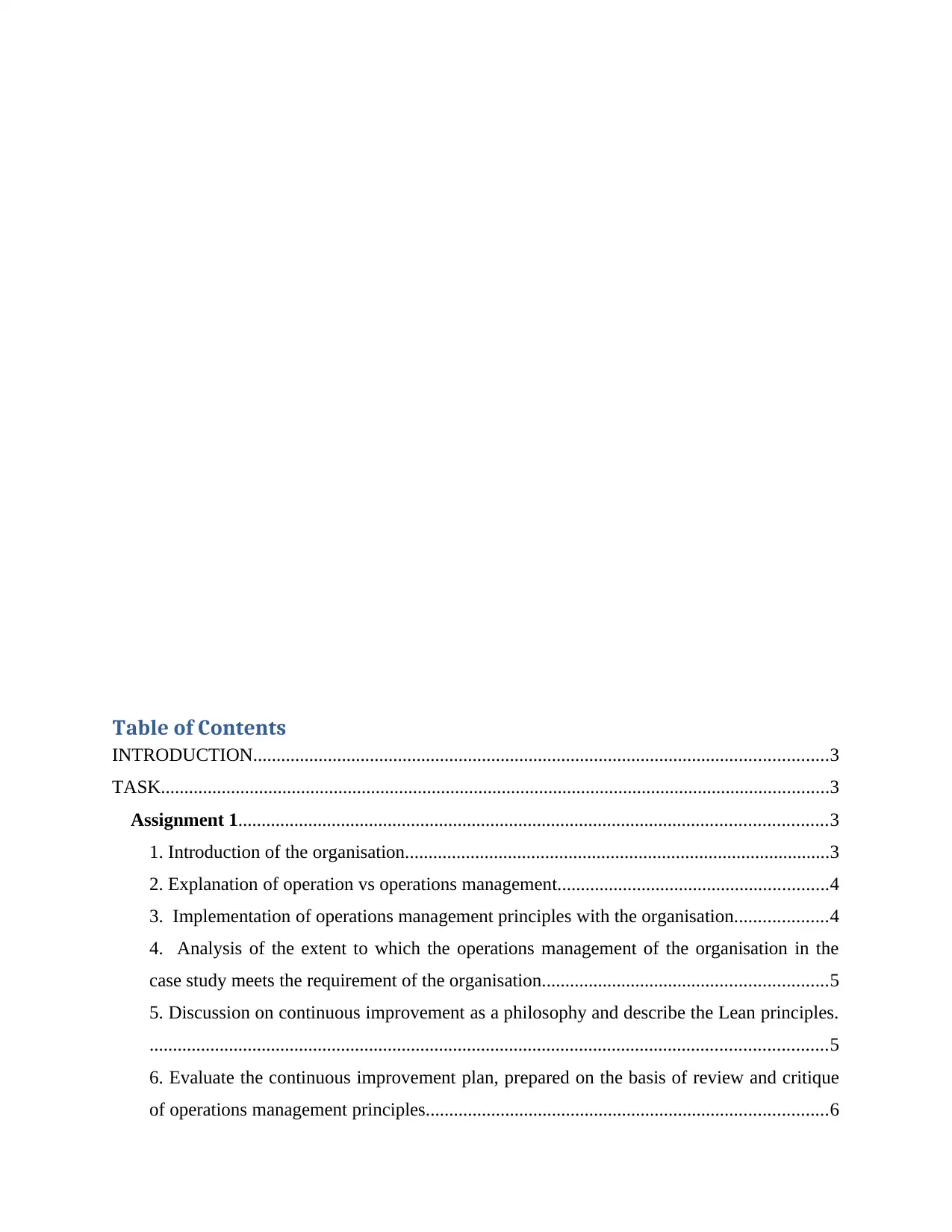
Table of Contents
INTRODUCTION...........................................................................................................................3
TASK...............................................................................................................................................3
Assignment 1..............................................................................................................................3
1. Introduction of the organisation...........................................................................................3
2. Explanation of operation vs operations management..........................................................4
3. Implementation of operations management principles with the organisation....................4
4. Analysis of the extent to which the operations management of the organisation in the
case study meets the requirement of the organisation.............................................................5
5. Discussion on continuous improvement as a philosophy and describe the Lean principles.
.................................................................................................................................................5
6. Evaluate the continuous improvement plan, prepared on the basis of review and critique
of operations management principles......................................................................................6
INTRODUCTION...........................................................................................................................3
TASK...............................................................................................................................................3
Assignment 1..............................................................................................................................3
1. Introduction of the organisation...........................................................................................3
2. Explanation of operation vs operations management..........................................................4
3. Implementation of operations management principles with the organisation....................4
4. Analysis of the extent to which the operations management of the organisation in the
case study meets the requirement of the organisation.............................................................5
5. Discussion on continuous improvement as a philosophy and describe the Lean principles.
.................................................................................................................................................5
6. Evaluate the continuous improvement plan, prepared on the basis of review and critique
of operations management principles......................................................................................6

7. Using continuous improvement plan, make at least two justified recommendations which
could improve the operations functions detailed in the case study........................................7
CONCLUSION........................................................................................................................7
ASSIGNMENT 2- PROJECT LIFE CYCLE.........................................................................8
INTRODUCTION...................................................................................................................8
Overview of the case study......................................................................................................8
Description and stages of Project Life cycle...........................................................................8
Analyse the rationale for the project methodologies, tools and leadership within the PLC for
the given project....................................................................................................................10
Analysis of the project methodologies and tools used...........................................................10
Evaluate the effectiveness of PLC in application to the project theories and models...........10
Critically analyse how the use of appropriate theories, concepts and models in the PLC will
differentiate between large and small-scale projects.............................................................11
Critically evaluate the PLC through a practical and theoretical exploration of its
effectiveness..........................................................................................................................11
CONCLUSION..............................................................................................................................11
REFERENCES..............................................................................................................................12
could improve the operations functions detailed in the case study........................................7
CONCLUSION........................................................................................................................7
ASSIGNMENT 2- PROJECT LIFE CYCLE.........................................................................8
INTRODUCTION...................................................................................................................8
Overview of the case study......................................................................................................8
Description and stages of Project Life cycle...........................................................................8
Analyse the rationale for the project methodologies, tools and leadership within the PLC for
the given project....................................................................................................................10
Analysis of the project methodologies and tools used...........................................................10
Evaluate the effectiveness of PLC in application to the project theories and models...........10
Critically analyse how the use of appropriate theories, concepts and models in the PLC will
differentiate between large and small-scale projects.............................................................11
Critically evaluate the PLC through a practical and theoretical exploration of its
effectiveness..........................................................................................................................11
CONCLUSION..............................................................................................................................11
REFERENCES..............................................................................................................................12
⊘ This is a preview!⊘
Do you want full access?
Subscribe today to unlock all pages.

Trusted by 1+ million students worldwide
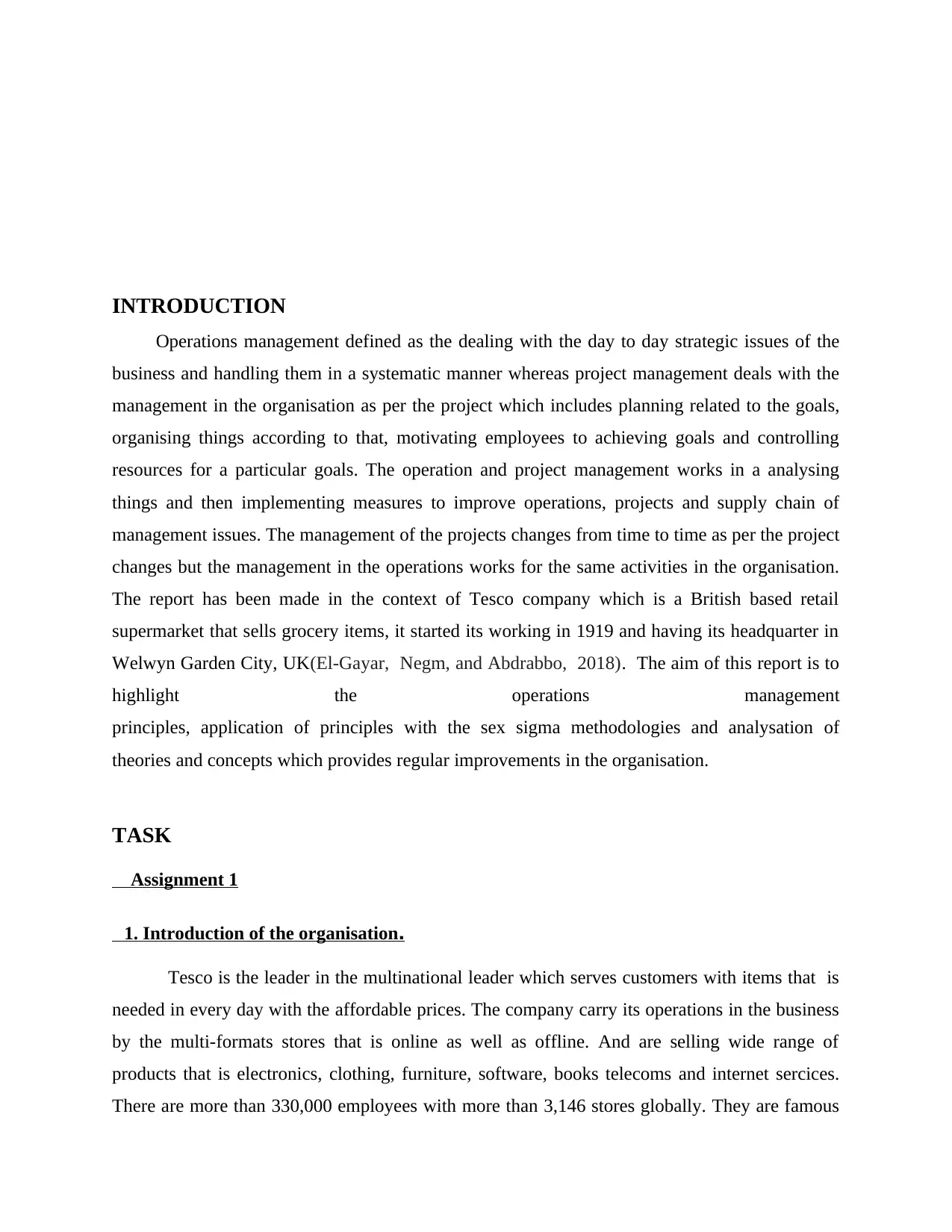
INTRODUCTION
Operations management defined as the dealing with the day to day strategic issues of the
business and handling them in a systematic manner whereas project management deals with the
management in the organisation as per the project which includes planning related to the goals,
organising things according to that, motivating employees to achieving goals and controlling
resources for a particular goals. The operation and project management works in a analysing
things and then implementing measures to improve operations, projects and supply chain of
management issues. The management of the projects changes from time to time as per the project
changes but the management in the operations works for the same activities in the organisation.
The report has been made in the context of Tesco company which is a British based retail
supermarket that sells grocery items, it started its working in 1919 and having its headquarter in
Welwyn Garden City, UK(El-Gayar, Negm, and Abdrabbo, 2018). The aim of this report is to
highlight the operations management
principles, application of principles with the sex sigma methodologies and analysation of
theories and concepts which provides regular improvements in the organisation.
TASK
Assignment 1
1. Introduction of the organisation.
Tesco is the leader in the multinational leader which serves customers with items that is
needed in every day with the affordable prices. The company carry its operations in the business
by the multi-formats stores that is online as well as offline. And are selling wide range of
products that is electronics, clothing, furniture, software, books telecoms and internet sercices.
There are more than 330,000 employees with more than 3,146 stores globally. They are famous
Operations management defined as the dealing with the day to day strategic issues of the
business and handling them in a systematic manner whereas project management deals with the
management in the organisation as per the project which includes planning related to the goals,
organising things according to that, motivating employees to achieving goals and controlling
resources for a particular goals. The operation and project management works in a analysing
things and then implementing measures to improve operations, projects and supply chain of
management issues. The management of the projects changes from time to time as per the project
changes but the management in the operations works for the same activities in the organisation.
The report has been made in the context of Tesco company which is a British based retail
supermarket that sells grocery items, it started its working in 1919 and having its headquarter in
Welwyn Garden City, UK(El-Gayar, Negm, and Abdrabbo, 2018). The aim of this report is to
highlight the operations management
principles, application of principles with the sex sigma methodologies and analysation of
theories and concepts which provides regular improvements in the organisation.
TASK
Assignment 1
1. Introduction of the organisation.
Tesco is the leader in the multinational leader which serves customers with items that is
needed in every day with the affordable prices. The company carry its operations in the business
by the multi-formats stores that is online as well as offline. And are selling wide range of
products that is electronics, clothing, furniture, software, books telecoms and internet sercices.
There are more than 330,000 employees with more than 3,146 stores globally. They are famous
Paraphrase This Document
Need a fresh take? Get an instant paraphrase of this document with our AI Paraphraser

for selling its products on a affordable price and now providing great packaging in the revised
range of products with avoiding artificial flavours and colours.
2. Explanation of operation vs operations management.
Operation management is defined as the management and making balance between the
output from different inputs. Its an act of operating activities with power and moral in order to
generate profit.
Operations management refers to management in the multidisciplinary area in the
organisation there are many resources(El-Gayar, Negm and Abdrabbo, 2018). It is concerned
with the organise, management and the improvement of the systems to create organisation goods
and services.
3. Implementation of operations management principles with the organisation.
Operations management is the management of the business practices that builds goods
and services. Operation Management comprises the activities that are planning, organizing and
supervising to ensure profitability and success in the organisation. The operation management of
Tesco with six sigma principles are Given below:
Define- The marketing strategies of Tesco involves the analysing and collecting the
information from the card scheme and examine the purchasing habits and patterns which
is helpful in segmenting customers.
Measures- In order to understanding the growth pattern of Tesco, they have applied the
concept of 4C's which includes customer benefit, customer cost , customer convenience
and the communication. This helps in measuring growth.
Analyse- Currently Tesco is facing some problems in marketing and customer basis, as
selecting right place for the stores in the market is being a challenge and making
increment in the growth of internet sales is also generating problem because of which
customer switching markets.
Design- This is the process of designing products as per the customer needs and using
promotional strategies to attracting new customers. Tesco is using different platforms to
advertise and to reach potential customers by continuously offering discounts.
range of products with avoiding artificial flavours and colours.
2. Explanation of operation vs operations management.
Operation management is defined as the management and making balance between the
output from different inputs. Its an act of operating activities with power and moral in order to
generate profit.
Operations management refers to management in the multidisciplinary area in the
organisation there are many resources(El-Gayar, Negm and Abdrabbo, 2018). It is concerned
with the organise, management and the improvement of the systems to create organisation goods
and services.
3. Implementation of operations management principles with the organisation.
Operations management is the management of the business practices that builds goods
and services. Operation Management comprises the activities that are planning, organizing and
supervising to ensure profitability and success in the organisation. The operation management of
Tesco with six sigma principles are Given below:
Define- The marketing strategies of Tesco involves the analysing and collecting the
information from the card scheme and examine the purchasing habits and patterns which
is helpful in segmenting customers.
Measures- In order to understanding the growth pattern of Tesco, they have applied the
concept of 4C's which includes customer benefit, customer cost , customer convenience
and the communication. This helps in measuring growth.
Analyse- Currently Tesco is facing some problems in marketing and customer basis, as
selecting right place for the stores in the market is being a challenge and making
increment in the growth of internet sales is also generating problem because of which
customer switching markets.
Design- This is the process of designing products as per the customer needs and using
promotional strategies to attracting new customers. Tesco is using different platforms to
advertise and to reach potential customers by continuously offering discounts.
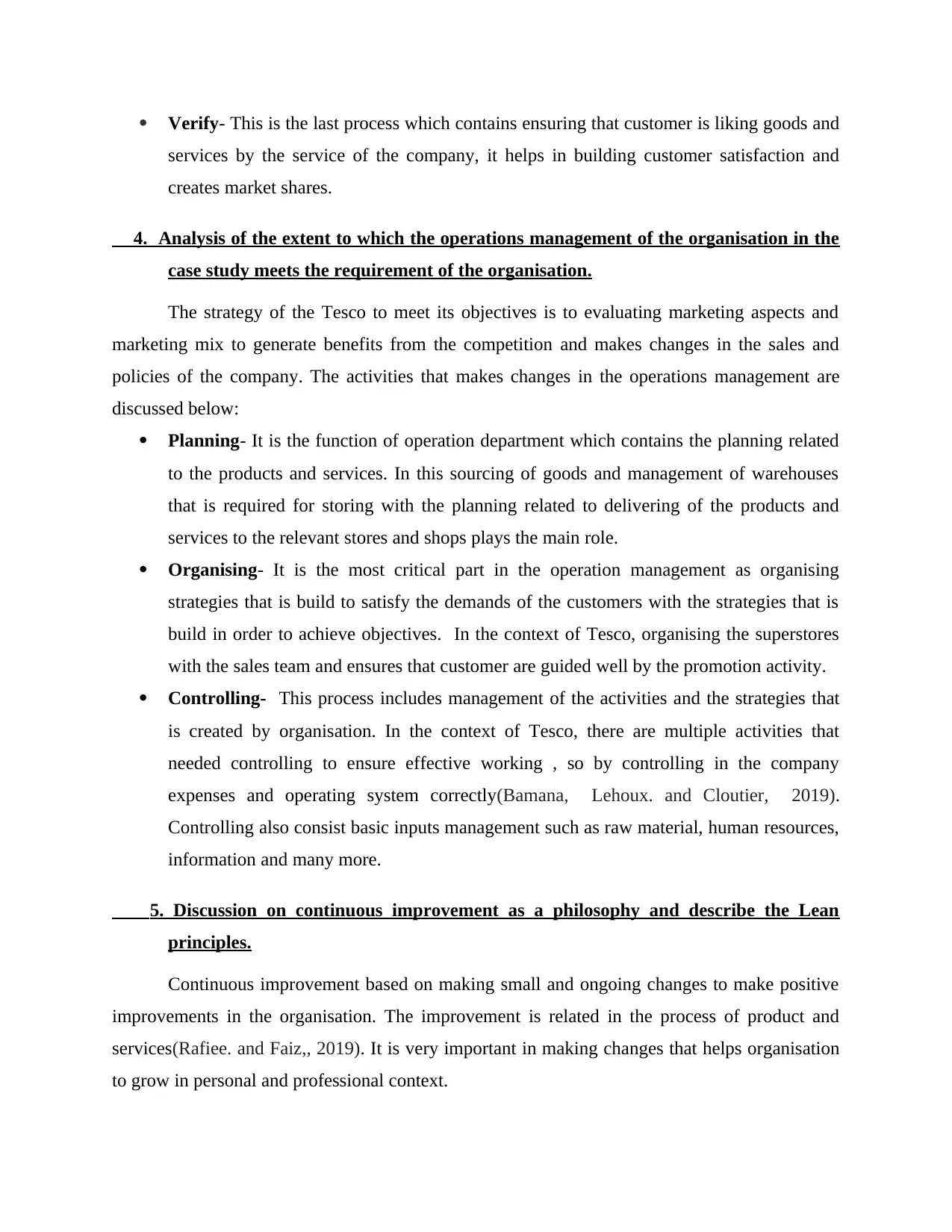
Verify- This is the last process which contains ensuring that customer is liking goods and
services by the service of the company, it helps in building customer satisfaction and
creates market shares.
4. Analysis of the extent to which the operations management of the organisation in the
case study meets the requirement of the organisation.
The strategy of the Tesco to meet its objectives is to evaluating marketing aspects and
marketing mix to generate benefits from the competition and makes changes in the sales and
policies of the company. The activities that makes changes in the operations management are
discussed below:
Planning- It is the function of operation department which contains the planning related
to the products and services. In this sourcing of goods and management of warehouses
that is required for storing with the planning related to delivering of the products and
services to the relevant stores and shops plays the main role.
Organising- It is the most critical part in the operation management as organising
strategies that is build to satisfy the demands of the customers with the strategies that is
build in order to achieve objectives. In the context of Tesco, organising the superstores
with the sales team and ensures that customer are guided well by the promotion activity.
Controlling- This process includes management of the activities and the strategies that
is created by organisation. In the context of Tesco, there are multiple activities that
needed controlling to ensure effective working , so by controlling in the company
expenses and operating system correctly(Bamana, Lehoux. and Cloutier, 2019).
Controlling also consist basic inputs management such as raw material, human resources,
information and many more.
5. Discussion on continuous improvement as a philosophy and describe the Lean
principles.
Continuous improvement based on making small and ongoing changes to make positive
improvements in the organisation. The improvement is related in the process of product and
services(Rafiee. and Faiz,, 2019). It is very important in making changes that helps organisation
to grow in personal and professional context.
services by the service of the company, it helps in building customer satisfaction and
creates market shares.
4. Analysis of the extent to which the operations management of the organisation in the
case study meets the requirement of the organisation.
The strategy of the Tesco to meet its objectives is to evaluating marketing aspects and
marketing mix to generate benefits from the competition and makes changes in the sales and
policies of the company. The activities that makes changes in the operations management are
discussed below:
Planning- It is the function of operation department which contains the planning related
to the products and services. In this sourcing of goods and management of warehouses
that is required for storing with the planning related to delivering of the products and
services to the relevant stores and shops plays the main role.
Organising- It is the most critical part in the operation management as organising
strategies that is build to satisfy the demands of the customers with the strategies that is
build in order to achieve objectives. In the context of Tesco, organising the superstores
with the sales team and ensures that customer are guided well by the promotion activity.
Controlling- This process includes management of the activities and the strategies that
is created by organisation. In the context of Tesco, there are multiple activities that
needed controlling to ensure effective working , so by controlling in the company
expenses and operating system correctly(Bamana, Lehoux. and Cloutier, 2019).
Controlling also consist basic inputs management such as raw material, human resources,
information and many more.
5. Discussion on continuous improvement as a philosophy and describe the Lean
principles.
Continuous improvement based on making small and ongoing changes to make positive
improvements in the organisation. The improvement is related in the process of product and
services(Rafiee. and Faiz,, 2019). It is very important in making changes that helps organisation
to grow in personal and professional context.
⊘ This is a preview!⊘
Do you want full access?
Subscribe today to unlock all pages.

Trusted by 1+ million students worldwide
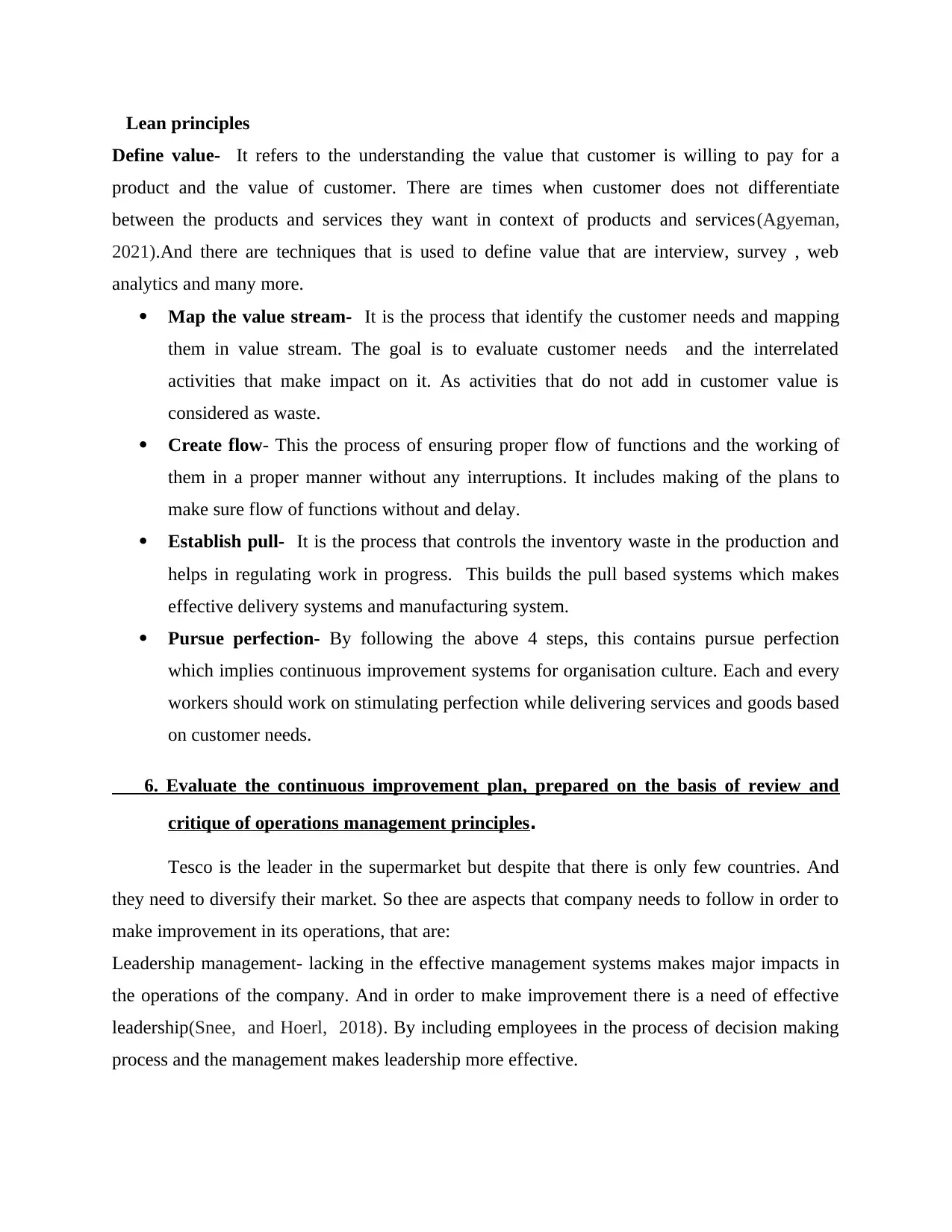
Lean principles
Define value- It refers to the understanding the value that customer is willing to pay for a
product and the value of customer. There are times when customer does not differentiate
between the products and services they want in context of products and services(Agyeman,
2021).And there are techniques that is used to define value that are interview, survey , web
analytics and many more.
Map the value stream- It is the process that identify the customer needs and mapping
them in value stream. The goal is to evaluate customer needs and the interrelated
activities that make impact on it. As activities that do not add in customer value is
considered as waste.
Create flow- This the process of ensuring proper flow of functions and the working of
them in a proper manner without any interruptions. It includes making of the plans to
make sure flow of functions without and delay.
Establish pull- It is the process that controls the inventory waste in the production and
helps in regulating work in progress. This builds the pull based systems which makes
effective delivery systems and manufacturing system.
Pursue perfection- By following the above 4 steps, this contains pursue perfection
which implies continuous improvement systems for organisation culture. Each and every
workers should work on stimulating perfection while delivering services and goods based
on customer needs.
6. Evaluate the continuous improvement plan, prepared on the basis of review and
critique of operations management principles.
Tesco is the leader in the supermarket but despite that there is only few countries. And
they need to diversify their market. So thee are aspects that company needs to follow in order to
make improvement in its operations, that are:
Leadership management- lacking in the effective management systems makes major impacts in
the operations of the company. And in order to make improvement there is a need of effective
leadership(Snee, and Hoerl, 2018). By including employees in the process of decision making
process and the management makes leadership more effective.
Define value- It refers to the understanding the value that customer is willing to pay for a
product and the value of customer. There are times when customer does not differentiate
between the products and services they want in context of products and services(Agyeman,
2021).And there are techniques that is used to define value that are interview, survey , web
analytics and many more.
Map the value stream- It is the process that identify the customer needs and mapping
them in value stream. The goal is to evaluate customer needs and the interrelated
activities that make impact on it. As activities that do not add in customer value is
considered as waste.
Create flow- This the process of ensuring proper flow of functions and the working of
them in a proper manner without any interruptions. It includes making of the plans to
make sure flow of functions without and delay.
Establish pull- It is the process that controls the inventory waste in the production and
helps in regulating work in progress. This builds the pull based systems which makes
effective delivery systems and manufacturing system.
Pursue perfection- By following the above 4 steps, this contains pursue perfection
which implies continuous improvement systems for organisation culture. Each and every
workers should work on stimulating perfection while delivering services and goods based
on customer needs.
6. Evaluate the continuous improvement plan, prepared on the basis of review and
critique of operations management principles.
Tesco is the leader in the supermarket but despite that there is only few countries. And
they need to diversify their market. So thee are aspects that company needs to follow in order to
make improvement in its operations, that are:
Leadership management- lacking in the effective management systems makes major impacts in
the operations of the company. And in order to make improvement there is a need of effective
leadership(Snee, and Hoerl, 2018). By including employees in the process of decision making
process and the management makes leadership more effective.
Paraphrase This Document
Need a fresh take? Get an instant paraphrase of this document with our AI Paraphraser
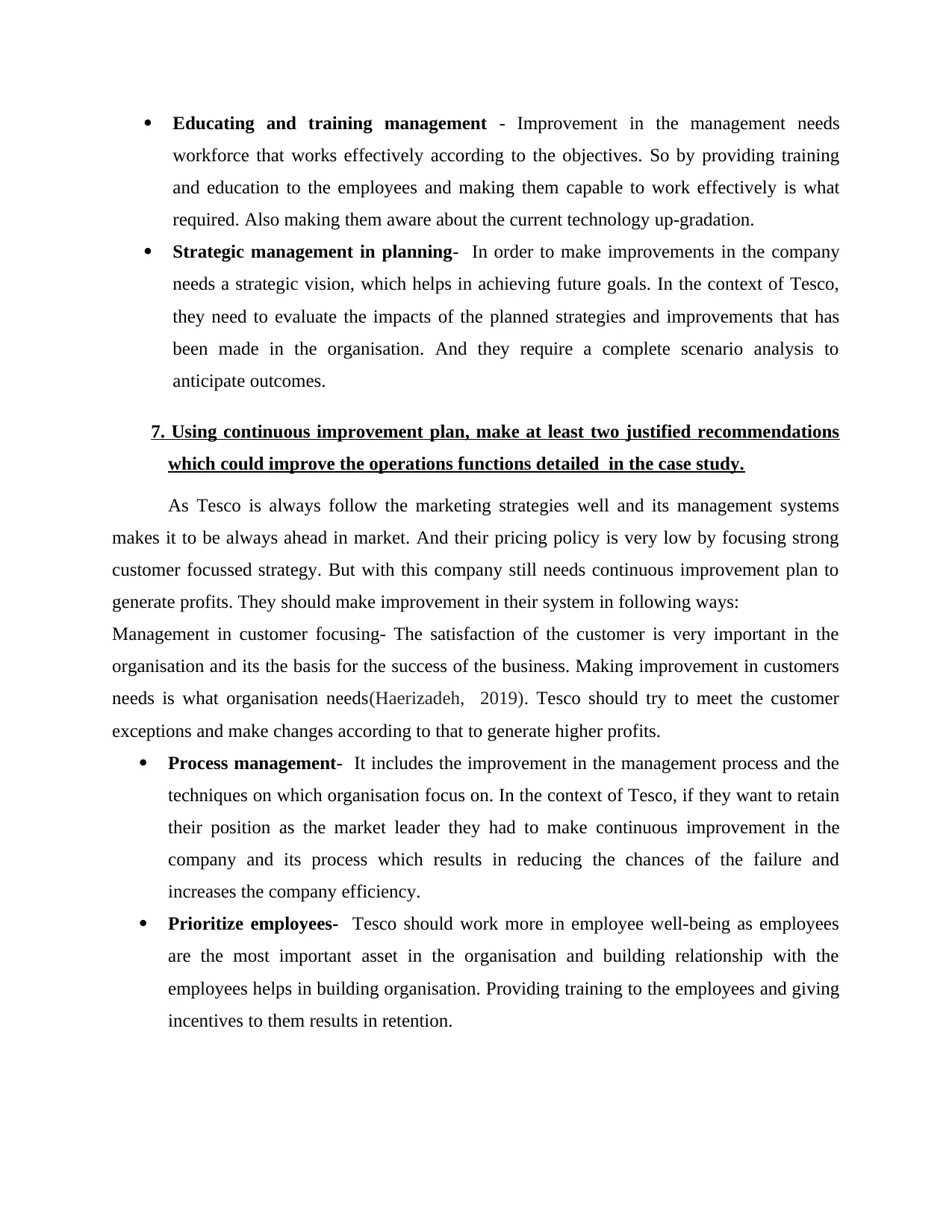
Educating and training management - Improvement in the management needs
workforce that works effectively according to the objectives. So by providing training
and education to the employees and making them capable to work effectively is what
required. Also making them aware about the current technology up-gradation.
Strategic management in planning- In order to make improvements in the company
needs a strategic vision, which helps in achieving future goals. In the context of Tesco,
they need to evaluate the impacts of the planned strategies and improvements that has
been made in the organisation. And they require a complete scenario analysis to
anticipate outcomes.
7. Using continuous improvement plan, make at least two justified recommendations
which could improve the operations functions detailed in the case study.
As Tesco is always follow the marketing strategies well and its management systems
makes it to be always ahead in market. And their pricing policy is very low by focusing strong
customer focussed strategy. But with this company still needs continuous improvement plan to
generate profits. They should make improvement in their system in following ways:
Management in customer focusing- The satisfaction of the customer is very important in the
organisation and its the basis for the success of the business. Making improvement in customers
needs is what organisation needs(Haerizadeh, 2019). Tesco should try to meet the customer
exceptions and make changes according to that to generate higher profits.
Process management- It includes the improvement in the management process and the
techniques on which organisation focus on. In the context of Tesco, if they want to retain
their position as the market leader they had to make continuous improvement in the
company and its process which results in reducing the chances of the failure and
increases the company efficiency.
Prioritize employees- Tesco should work more in employee well-being as employees
are the most important asset in the organisation and building relationship with the
employees helps in building organisation. Providing training to the employees and giving
incentives to them results in retention.
workforce that works effectively according to the objectives. So by providing training
and education to the employees and making them capable to work effectively is what
required. Also making them aware about the current technology up-gradation.
Strategic management in planning- In order to make improvements in the company
needs a strategic vision, which helps in achieving future goals. In the context of Tesco,
they need to evaluate the impacts of the planned strategies and improvements that has
been made in the organisation. And they require a complete scenario analysis to
anticipate outcomes.
7. Using continuous improvement plan, make at least two justified recommendations
which could improve the operations functions detailed in the case study.
As Tesco is always follow the marketing strategies well and its management systems
makes it to be always ahead in market. And their pricing policy is very low by focusing strong
customer focussed strategy. But with this company still needs continuous improvement plan to
generate profits. They should make improvement in their system in following ways:
Management in customer focusing- The satisfaction of the customer is very important in the
organisation and its the basis for the success of the business. Making improvement in customers
needs is what organisation needs(Haerizadeh, 2019). Tesco should try to meet the customer
exceptions and make changes according to that to generate higher profits.
Process management- It includes the improvement in the management process and the
techniques on which organisation focus on. In the context of Tesco, if they want to retain
their position as the market leader they had to make continuous improvement in the
company and its process which results in reducing the chances of the failure and
increases the company efficiency.
Prioritize employees- Tesco should work more in employee well-being as employees
are the most important asset in the organisation and building relationship with the
employees helps in building organisation. Providing training to the employees and giving
incentives to them results in retention.

CONCLUSION
From the above report it is concluded that the operations management is the procedure of
managing the whole functions of organisation. This report includes application of operation
management with the theory of six sigma. It also defines continuous improvement theory and
the lean principles. This also consist the operation management helps in employee well-being
and make them retain in the company.
ASSIGNMENT 2- PROJECT LIFE CYCLE
INTRODUCTION
Project life cycle is defined as the process of planning, organizing, controlling and
monitoring the business projects efficiently across all the levels for effective execution. The
report is based on the case study of change program for the manufacturing organisation in which
the project manager is provided with the task plan and manage an in-house project to transform
the business objectives into the developed project.
Overview of the case study
This the case study which provided change program for a large organisation. The case
study tells about the a site which have 1250 employees and there is no on site catering. The
company have employees of office staff and factory workers(Ganesh. and Marathe, 2018) . The
project manager asked to managing an in-housing project to achieve business goals. It is the task
of project manager to apply project life cycle on identified projects based on objectives.
Description and stages of Project Life cycle
The project life cycle includes the stages that are required to effectively manage it from
beginning to end by the project managers. The change program and application of PLC to
identify projects in manufacturing organization, includes stageswhich helps in determining
progress of project. There are four stages which are as follows:
Project Initiation : This is the first stage of project life cycle that helps to visualise the
outcomes of a project. It is performed to ensure project alignment in order to get approval
on the projects and programmes by the sponsoring body. The objectives of this
From the above report it is concluded that the operations management is the procedure of
managing the whole functions of organisation. This report includes application of operation
management with the theory of six sigma. It also defines continuous improvement theory and
the lean principles. This also consist the operation management helps in employee well-being
and make them retain in the company.
ASSIGNMENT 2- PROJECT LIFE CYCLE
INTRODUCTION
Project life cycle is defined as the process of planning, organizing, controlling and
monitoring the business projects efficiently across all the levels for effective execution. The
report is based on the case study of change program for the manufacturing organisation in which
the project manager is provided with the task plan and manage an in-house project to transform
the business objectives into the developed project.
Overview of the case study
This the case study which provided change program for a large organisation. The case
study tells about the a site which have 1250 employees and there is no on site catering. The
company have employees of office staff and factory workers(Ganesh. and Marathe, 2018) . The
project manager asked to managing an in-housing project to achieve business goals. It is the task
of project manager to apply project life cycle on identified projects based on objectives.
Description and stages of Project Life cycle
The project life cycle includes the stages that are required to effectively manage it from
beginning to end by the project managers. The change program and application of PLC to
identify projects in manufacturing organization, includes stageswhich helps in determining
progress of project. There are four stages which are as follows:
Project Initiation : This is the first stage of project life cycle that helps to visualise the
outcomes of a project. It is performed to ensure project alignment in order to get approval
on the projects and programmes by the sponsoring body. The objectives of this
⊘ This is a preview!⊘
Do you want full access?
Subscribe today to unlock all pages.

Trusted by 1+ million students worldwide
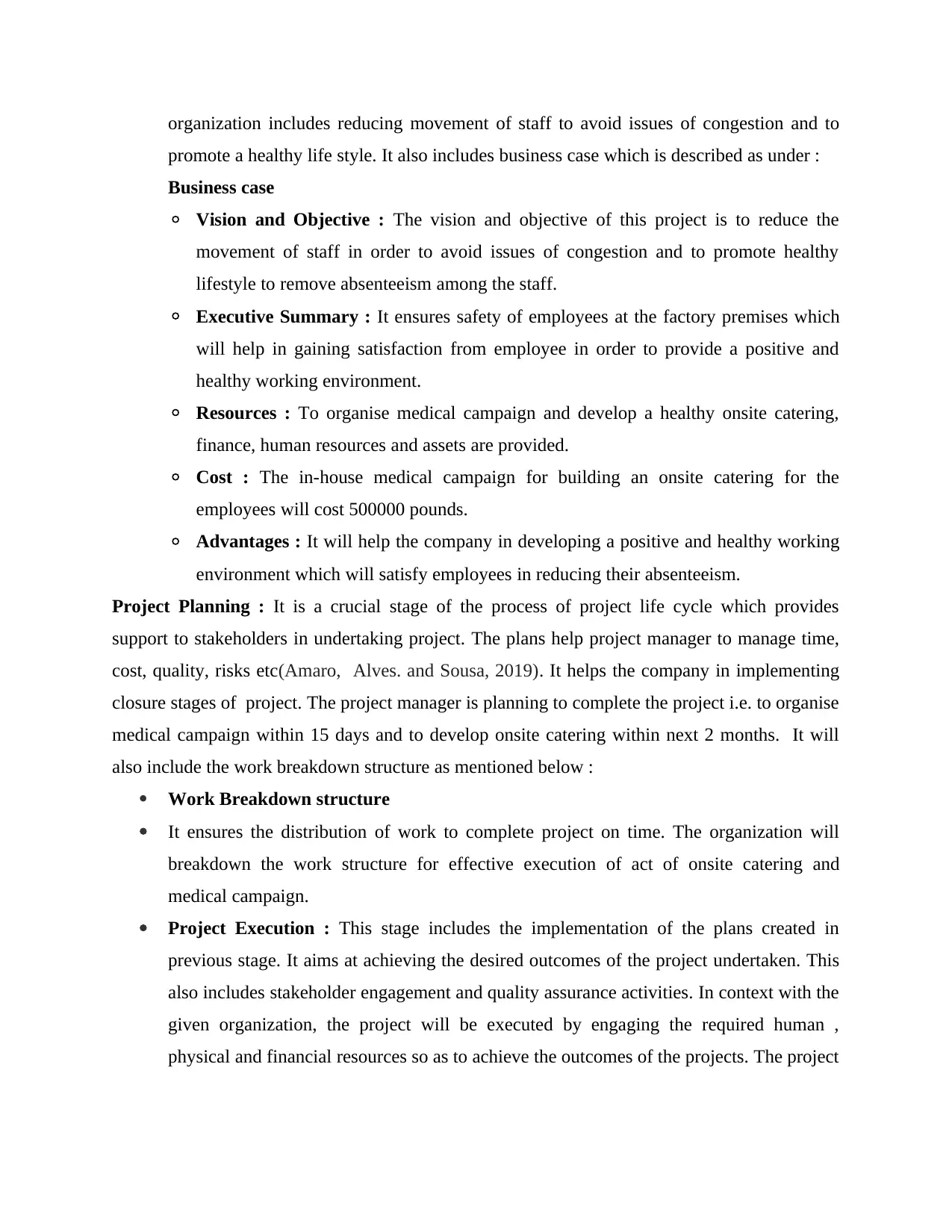
organization includes reducing movement of staff to avoid issues of congestion and to
promote a healthy life style. It also includes business case which is described as under :
Business case
◦ Vision and Objective : The vision and objective of this project is to reduce the
movement of staff in order to avoid issues of congestion and to promote healthy
lifestyle to remove absenteeism among the staff.
◦ Executive Summary : It ensures safety of employees at the factory premises which
will help in gaining satisfaction from employee in order to provide a positive and
healthy working environment.
◦ Resources : To organise medical campaign and develop a healthy onsite catering,
finance, human resources and assets are provided.
◦ Cost : The in-house medical campaign for building an onsite catering for the
employees will cost 500000 pounds.
◦ Advantages : It will help the company in developing a positive and healthy working
environment which will satisfy employees in reducing their absenteeism.
Project Planning : It is a crucial stage of the process of project life cycle which provides
support to stakeholders in undertaking project. The plans help project manager to manage time,
cost, quality, risks etc(Amaro, Alves. and Sousa, 2019). It helps the company in implementing
closure stages of project. The project manager is planning to complete the project i.e. to organise
medical campaign within 15 days and to develop onsite catering within next 2 months. It will
also include the work breakdown structure as mentioned below :
Work Breakdown structure
It ensures the distribution of work to complete project on time. The organization will
breakdown the work structure for effective execution of act of onsite catering and
medical campaign.
Project Execution : This stage includes the implementation of the plans created in
previous stage. It aims at achieving the desired outcomes of the project undertaken. This
also includes stakeholder engagement and quality assurance activities. In context with the
given organization, the project will be executed by engaging the required human ,
physical and financial resources so as to achieve the outcomes of the projects. The project
promote a healthy life style. It also includes business case which is described as under :
Business case
◦ Vision and Objective : The vision and objective of this project is to reduce the
movement of staff in order to avoid issues of congestion and to promote healthy
lifestyle to remove absenteeism among the staff.
◦ Executive Summary : It ensures safety of employees at the factory premises which
will help in gaining satisfaction from employee in order to provide a positive and
healthy working environment.
◦ Resources : To organise medical campaign and develop a healthy onsite catering,
finance, human resources and assets are provided.
◦ Cost : The in-house medical campaign for building an onsite catering for the
employees will cost 500000 pounds.
◦ Advantages : It will help the company in developing a positive and healthy working
environment which will satisfy employees in reducing their absenteeism.
Project Planning : It is a crucial stage of the process of project life cycle which provides
support to stakeholders in undertaking project. The plans help project manager to manage time,
cost, quality, risks etc(Amaro, Alves. and Sousa, 2019). It helps the company in implementing
closure stages of project. The project manager is planning to complete the project i.e. to organise
medical campaign within 15 days and to develop onsite catering within next 2 months. It will
also include the work breakdown structure as mentioned below :
Work Breakdown structure
It ensures the distribution of work to complete project on time. The organization will
breakdown the work structure for effective execution of act of onsite catering and
medical campaign.
Project Execution : This stage includes the implementation of the plans created in
previous stage. It aims at achieving the desired outcomes of the project undertaken. This
also includes stakeholder engagement and quality assurance activities. In context with the
given organization, the project will be executed by engaging the required human ,
physical and financial resources so as to achieve the outcomes of the projects. The project
Paraphrase This Document
Need a fresh take? Get an instant paraphrase of this document with our AI Paraphraser
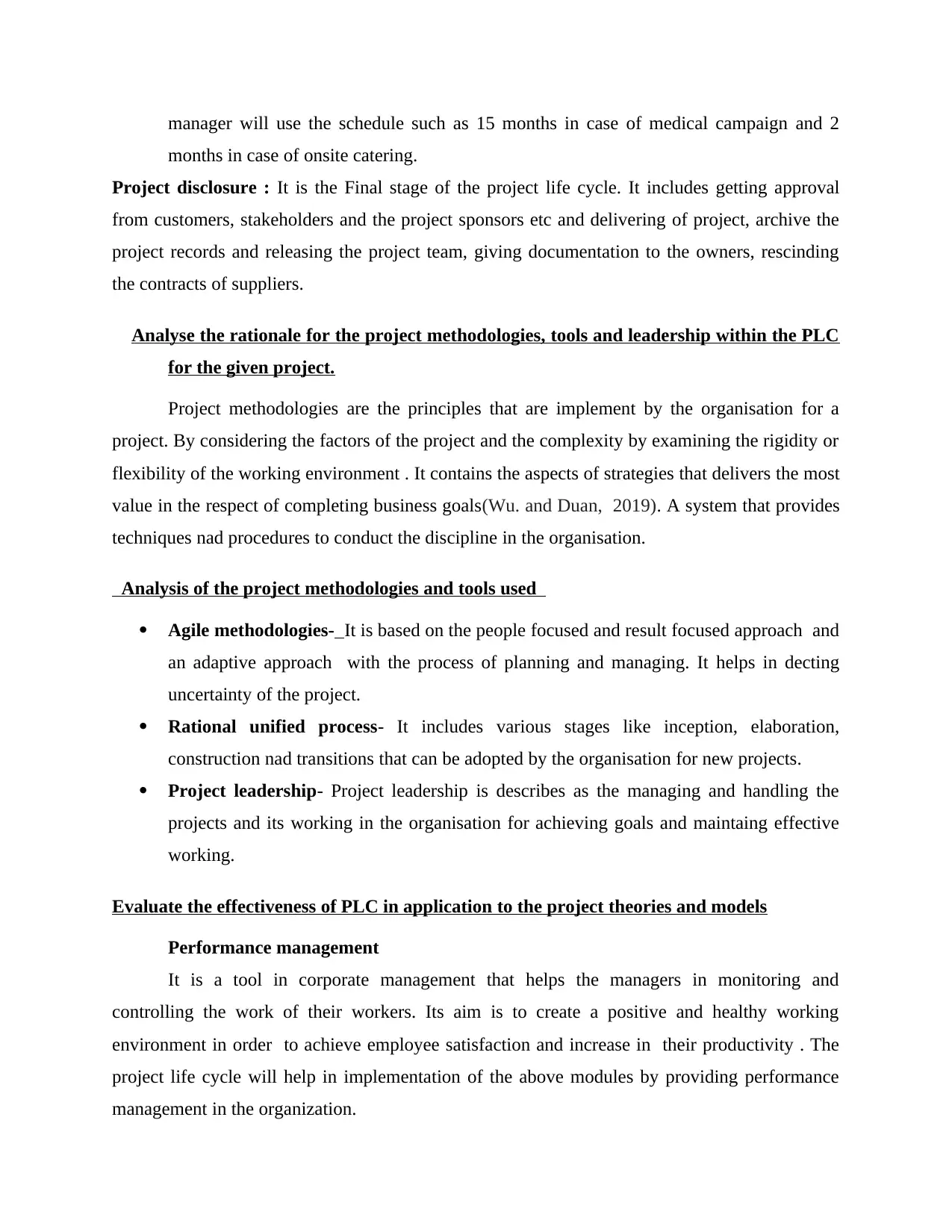
manager will use the schedule such as 15 months in case of medical campaign and 2
months in case of onsite catering.
Project disclosure : It is the Final stage of the project life cycle. It includes getting approval
from customers, stakeholders and the project sponsors etc and delivering of project, archive the
project records and releasing the project team, giving documentation to the owners, rescinding
the contracts of suppliers.
Analyse the rationale for the project methodologies, tools and leadership within the PLC
for the given project.
Project methodologies are the principles that are implement by the organisation for a
project. By considering the factors of the project and the complexity by examining the rigidity or
flexibility of the working environment . It contains the aspects of strategies that delivers the most
value in the respect of completing business goals(Wu. and Duan, 2019). A system that provides
techniques nad procedures to conduct the discipline in the organisation.
Analysis of the project methodologies and tools used
Agile methodologies- It is based on the people focused and result focused approach and
an adaptive approach with the process of planning and managing. It helps in decting
uncertainty of the project.
Rational unified process- It includes various stages like inception, elaboration,
construction nad transitions that can be adopted by the organisation for new projects.
Project leadership- Project leadership is describes as the managing and handling the
projects and its working in the organisation for achieving goals and maintaing effective
working.
Evaluate the effectiveness of PLC in application to the project theories and models
Performance management
It is a tool in corporate management that helps the managers in monitoring and
controlling the work of their workers. Its aim is to create a positive and healthy working
environment in order to achieve employee satisfaction and increase in their productivity . The
project life cycle will help in implementation of the above modules by providing performance
management in the organization.
months in case of onsite catering.
Project disclosure : It is the Final stage of the project life cycle. It includes getting approval
from customers, stakeholders and the project sponsors etc and delivering of project, archive the
project records and releasing the project team, giving documentation to the owners, rescinding
the contracts of suppliers.
Analyse the rationale for the project methodologies, tools and leadership within the PLC
for the given project.
Project methodologies are the principles that are implement by the organisation for a
project. By considering the factors of the project and the complexity by examining the rigidity or
flexibility of the working environment . It contains the aspects of strategies that delivers the most
value in the respect of completing business goals(Wu. and Duan, 2019). A system that provides
techniques nad procedures to conduct the discipline in the organisation.
Analysis of the project methodologies and tools used
Agile methodologies- It is based on the people focused and result focused approach and
an adaptive approach with the process of planning and managing. It helps in decting
uncertainty of the project.
Rational unified process- It includes various stages like inception, elaboration,
construction nad transitions that can be adopted by the organisation for new projects.
Project leadership- Project leadership is describes as the managing and handling the
projects and its working in the organisation for achieving goals and maintaing effective
working.
Evaluate the effectiveness of PLC in application to the project theories and models
Performance management
It is a tool in corporate management that helps the managers in monitoring and
controlling the work of their workers. Its aim is to create a positive and healthy working
environment in order to achieve employee satisfaction and increase in their productivity . The
project life cycle will help in implementation of the above modules by providing performance
management in the organization.

Key Performance indicators
They are the quantifiable measures of performance for the achievement of objectives of
the project. It include Revenue Growth, Customer and employee satisfaction, Reduction in
employee turnover etc. In context of Tesco, it can use these indicators to analyse the
performance of its employees and can reduce the absenteeism of employees by achieving
employee satisfaction.
Critically analyse how the use of appropriate theories, concepts and models in the PLC
will differentiate between large and small-scale projects.
The use of appropriate theories and concept in project life cycle describes the connect
between project input, activities and outcomes, and generates a basis of how programs are used
to work for the evaluation of program performance. Theories helps in establishing the system
target and establish project management system within its matrix in the large scale project.
The use of concepts in theories and concept have different perspective on small scale
projects as each pattern has to be explored in differently in the limited knowledge and scope.
Contribution of leading theories in small scale projects helps in building different aspect of the
projects.
Critically evaluate the PLC through a practical and theoretical exploration of its
effectiveness.
The life cycle of the project includes a series of the steps that a project go through from
very start to the finish. A project life cycle consist four step framework which is initiation,
planning, execution and closure(Meng, 2019). Organisation has to expand their marketing
strategies as organising medical campaign to aware general public about the company and
providing on site catering for the employees who are going outside of the premises to get food
for themselves. PLC is design to help project managers to provide guide their project succesfully
from start to finish.
They are the quantifiable measures of performance for the achievement of objectives of
the project. It include Revenue Growth, Customer and employee satisfaction, Reduction in
employee turnover etc. In context of Tesco, it can use these indicators to analyse the
performance of its employees and can reduce the absenteeism of employees by achieving
employee satisfaction.
Critically analyse how the use of appropriate theories, concepts and models in the PLC
will differentiate between large and small-scale projects.
The use of appropriate theories and concept in project life cycle describes the connect
between project input, activities and outcomes, and generates a basis of how programs are used
to work for the evaluation of program performance. Theories helps in establishing the system
target and establish project management system within its matrix in the large scale project.
The use of concepts in theories and concept have different perspective on small scale
projects as each pattern has to be explored in differently in the limited knowledge and scope.
Contribution of leading theories in small scale projects helps in building different aspect of the
projects.
Critically evaluate the PLC through a practical and theoretical exploration of its
effectiveness.
The life cycle of the project includes a series of the steps that a project go through from
very start to the finish. A project life cycle consist four step framework which is initiation,
planning, execution and closure(Meng, 2019). Organisation has to expand their marketing
strategies as organising medical campaign to aware general public about the company and
providing on site catering for the employees who are going outside of the premises to get food
for themselves. PLC is design to help project managers to provide guide their project succesfully
from start to finish.
⊘ This is a preview!⊘
Do you want full access?
Subscribe today to unlock all pages.

Trusted by 1+ million students worldwide
1 out of 14
Related Documents
Your All-in-One AI-Powered Toolkit for Academic Success.
+13062052269
info@desklib.com
Available 24*7 on WhatsApp / Email
![[object Object]](/_next/static/media/star-bottom.7253800d.svg)
Unlock your academic potential
Copyright © 2020–2025 A2Z Services. All Rights Reserved. Developed and managed by ZUCOL.



